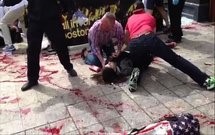 Two deadly blasts disrupted the Boston Marathon today. The people of Boston have been terrorized and are panicked. International media are seeking information and inadvertently magnifying and spreading fear, while federal, state and metropolitan authorities are working to secure the city, treat the wounded, investigate the scene and hunt down the perpetrator(s).
Two deadly blasts disrupted the Boston Marathon today. The people of Boston have been terrorized and are panicked. International media are seeking information and inadvertently magnifying and spreading fear, while federal, state and metropolitan authorities are working to secure the city, treat the wounded, investigate the scene and hunt down the perpetrator(s).
With the attack over, everyone is left waiting for answers. Why was the marathon attacked? Who conducted the attack? What was the motive? In some attacks, the answers come quickly, as with the July 7, 2005, London transit bombings. In other cases, it can take years before those answers appear, as with the 1996 Olympic Park bombing in Atlanta.
The attack venue will greatly aid the search for answers. The heavy presence of people and media that presumably drew the attacker to target the Boston Marathon may prove to be the perpetrator's undoing if someone captured a photo of them delivering the devices. Indeed, there are reports that a man was photographed carrying multiple backpacks near the scene of the attack -- although at a major marathon the sight of a person carrying multiple backpacks or gear bags to friends at the finish line is not unusual.
At first look, the devices used in the attack appear to have been rudimentary explosive devices constructed with a common homemade explosive mixture. In other words, virtually anyone could have constructed them using readily available items. Although made of common items, it appears the bombmaker intended the devices to cause maximum casualties by adding shrapnel to multiple devices planted at a heavily congested event.
Still, investigators will painstakingly search the crime scene for evidence that could help identify the bombmaker. They will look for fragments of the device that they can use to potentially trace their origin. They will also be looking for evidence that could identify the bombmaker, such as fingerprints, fiber evidence and traces of DNA. If reports of multiple undetonated devices being located are true -- and they may not be, since in the wake of a blast everything tends to look like an improvised explosive device -- then the undetonated devices will provide a treasure trove of forensic evidence for the investigators to work with.
While any number of actors could have conducted this attack based on the simplicity of the devices, it took some degree of planning to create and place multiple devices. Many different types of groups have used multiple devices in terrorist attacks, so that fact alone does not help identify the culprits. But if there were multiple unexploded devices recovered from different areas in Boston in addition to the two that did detonate, this would indicate that more than one person carried out the attacks, meaning an organized group was involved rather than a lone wolf. Multiple unexploded devices could suggest some sort of tactical incompetence presented by the attackers. Long race venues such as the Boston Marathon also spread out security resources over large areas, likely allowing the attackers to more easily plant multiple devices throughout the city without being detected.
The identity of the perpetrator(s) will be critical to determining the U.S. reaction to the attack. A domestic group, or even a grassroots group without direct external connections, would cause a different reaction than if the attacker or attackers have direct connections to a foreign terrorist group like al Qaeda or one of its regional franchises.
But we will have to wait for that answer.
Courtesy : Stratfor (www.stratfor.com)